Inadequate software testing can lead to severe consequences. System crashes, security breaches, and poor user experiences are common outcomes. Testing is crucial to identify and rectify defects, ensuring software reliability and performance. By investing in thorough testing, businesses can safeguard their reputation, reduce costs, and enhance customer satisfaction.
This article explores the significance of software testing, analyzing 7 compelling benefits that highlight its crucial role in the development process. By understanding these advantages, businesses can make informed decisions about their testing strategies and reap the rewards of high-quality software.
>> Read more:
- A Comprehensive Guide to Software Testing Life Cycle (STLC)
- 4 Levels Of Testing In Software Testing
- Detailed Explanation of 7 Software Testing Principles
- Difference between Verification and Validation in Software Testing
Ensure Software Quality
Software quality encompasses key attributes such as dependability, usability, performance, security, and maintainability. A defective software product can lead to customer dissatisfaction, financial losses, and potential legal repercussions. By prioritizing software quality, development teams can create robust solutions that are reliable, efficient, and secure, resulting in higher customer satisfaction and enhanced business success.
Detecting and Fixing Bugs
Errors can cause system failures, data loss, and a poor user experience. Proactive error detection and prevention are crucial for software development. Comprehensive testing strategies, including unit testing, integration testing, and system testing, help identify and rectify defects early in the development lifecycle. This ensures the software adheres to specified requirements, optimizes performance, and mitigates security risks.
Validating Software Functionality
Testing ensures that all features of the software work as intended. Functional testing validates that the software meets user requirements and performs correctly under various conditions. This thorough validation helps ensure the software provides the intended value to users and meets their expectations.
Enhancing Performance and Reliability
Performance testing is essential for determining how the software performs under different conditions, such as peak loads. By optimizing performance through rigorous testing, developers can ensure the software remains efficient and reliable. Reliability testing further ensures that the software maintains consistent performance over time, contributing to a dependable user experience.

Mitigate Software Risk
Functional failures, performance snags, security flaws, dependability issues, and maintainability difficulties are just a few of the many possible problems that fall under the umbrella of software risk. When software is riddled with defects, it can be difficult to maintain, hindering future development efforts and increasing costs. To mitigate these risks, ensuring software quality through rigorous testing is paramount.
Identifying and Addressing Vulnerabilities
By doing vulnerability assessments, penetration testing, code reviews, and risk assessments, organizations can identify and evaluate possible risks. Deploying security patches quickly and providing comprehensive security training to staff can effectively reduce vulnerabilities and safeguards against cyber threats.
Ensuring Compliance with Industry Standards
Organizations can build trust, reduce risks, and improve product quality by adhering to industry standards. Understanding the standards, carrying out exhaustive testing to confirm adherence, and putting required adjustments into practice are all part of compliance. Moreover, staying updated about the changing industry norms to ensure compliance and achieve a competitive advantage.
Avoiding System Crashes and Operational Failures
Thorough testing, which includes stress, load, and performance testing, is essential for detecting possible vulnerabilities and bottlenecks. Risks can be reduced by putting in place redundancy, failover procedures, and routine system monitoring.
In addition, placing code quality as a priority, following coding standards, and performing code reviews can greatly diminish the probability of errors. Businesses may create software systems that are resilient and able to handle unforeseen obstacles by combining these tactics.

>> Read more: What is Security Testing in Software Testing?
Enhance Customer Satisfaction
A terrible customer experience can lead to long-term consequences, including customer churn and damage to the brand's reputation. Negative word-of-mouth spreads rapidly through online reviews and social media, impacting customer acquisition and retention.
Improving Customer Satisfaction
To thrive in today's competitive market, improving customer satisfaction should be a top priority. This involves gathering and acting on customer feedback, conducting usability testing, and ensuring the software is user-friendly and reliable. Usability testing helps identify and fix issues, making the software intuitive and easy to use. Reliable software minimizes disruptions and provides a seamless user experience, which is essential for customer satisfaction
Building Trust and Loyalty
Investing in software testing leads to a better customer experience, increased customer satisfaction, and long-term business success. When software meets users' expectations and performs reliably, it builds trust. Satisfied customers are more likely to become repeat users and advocate for the product, contributing to the business's long-term success.

Reduce Cost
Prioritizing software testing is a strategic investment with significant financial returns. Ineffective testing can result in large expenditures due to defects identified after product release, including costly repairs, customer refunds, and reputational harm. In highly regulated industries, a lack of thorough testing can also lead to substantial fines and legal fees.
Businesses that detect and correct defects early in the development process can dramatically minimize the expenses associated with rework and post-release corrections. This leads to improved profit margins and a higher return on investment (ROI). Adequate testing helps reduce financial risks, safeguarding the organization from costly software failures.

Enhance Development Process
In today's rapidly evolving market, speed is a critical factor. Faster time-to-market enables businesses to capitalize on market opportunities, gain a competitive edge, and increase revenue more quickly. By accelerating the development and release process through efficient testing strategies, companies can meet customer demands more effectively, gather valuable market feedback, and have faster iterative development.
A shorter time-to-market also helps to reduce development costs by optimizing resource allocation. Ultimately, a well-executed testing strategy is essential for achieving a faster time-to-market without compromising software quality.

Tips For Successful Software Testing
Successful software testing is pivotal for business success. It ensures product quality, and customer satisfaction, and reduces potential financial losses. Here are key considerations:
Aligning Testing with Business Objectives
- Define clear and measurable testing objectives that directly contribute to achieving key business goals like revenue generation, cost efficiency, and customer satisfaction.
- Focus on testing areas that have the greatest impact on critical business processes and customer experience. Organizations can justify testing investments and demonstrate a positive impact on the bottom line.
- Allocate testing resources accordingly to mitigate risks in critical business functions, preventing costly failures and protecting reputation.
Comprehensive Test Coverage
Achieving comprehensive test coverage is essential for delivering high-quality software.
- Create an effective test design to adequately address all functional and non-functional testing requirements, maximizing test coverage while minimizing redundancy.
- Use test case prioritization design techniques to focus on high-risk areas. Employ test coverage analysis tools to measure and improve your testing effectiveness.
- Maintain realistic and stable test environments is vital for accurately simulating real-world conditions. You can identify potential issues early in the development cycle by replicating production-like environments.
- Consider using environment configuration management tools to streamline the process and ensure consistency.
>> Read more:
- A Guide to Functional Testing for Ensuring Flawless Software
- A Comprehensive Guide to Non-Functional Testing (NFT)
Effective Test Planning and Execution
- Test Strategy: Develop a comprehensive test plan with clear test objectives, scope, resources, and a realistic timeline.
- Test Automation: Increase efficiency with automation, focusing on repetitive test cases. Implement robust frameworks and embrace continuous testing within the SDLC for early defect detection and reduced bottlenecks.
>> Read more:
- How to Write A Powerful Test Plan in Software Testing?
- An Ultimate Guide to Different Test Case Design Techniques
Collaboration and Communication
Strong collaboration among cross-functional teams is essential for successful software testing.
- Foster open communication and shared ownership among development, testing, and business stakeholders.
- Implement efficient defect management processes with tracking tools to prioritize and monitor issues.
- Provide regular, clear test reports with actionable information on progress, results, and defects. Use visualization tools for complex information.
Quality Assurance Mindset
A strong quality assurance (QA) mindset is essential for delivering exceptional software products.
- Shift your focus from defect detection to defect prevention by implementing proactive quality practices.
- Adhere to industry-recognized quality standards and best practices to ensure product excellence.
- Continuously analyze test results and quality metrics to identify areas for improvement and optimize QA processes.
>> Read more: The Importance Of Software Maintenance
Conclusion
By prioritizing testing throughout the software development lifecycle, businesses can enhance product quality, reduce costs, mitigate risks, and ultimately achieve greater success. The benefits explored in this article underscore the undeniable importance of software testing in today's competitive market. Organizations can deliver exceptional software products that delight customers and drive business growth by embracing a robust testing strategy.
>>> Follow and Contact Relia Software for more information!
- development

